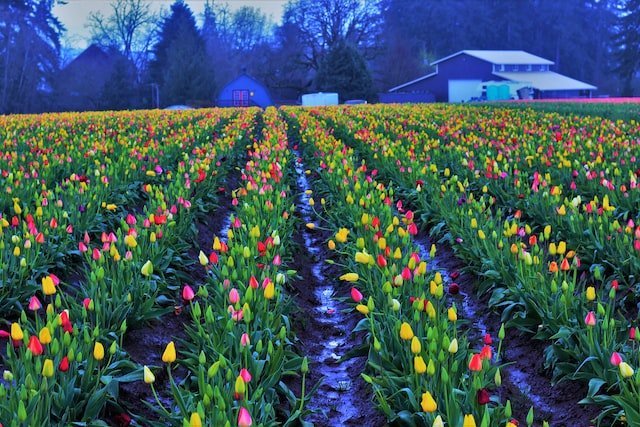From this ultimate guide on tulip farming, get to know Origin, Varieties, Climate, Soil, Temperature, Propagation, Irrigation, Fertilizers, etc. to get higher yield. According to analyses and market trends, market value size of tulips will be around USD 8.61 Billion in 2029.
Mostly in Asian countries, demand for fresh as well as dry tulips are higher. This is due to the fact that in Asian countries, tulips are widely used for decoration in weddings & other parties. Therefore, tulip farmers can earn money by selling their produce to agencies concerned with wedding decorations or parties.
There are other earning scopes too that we will discuss later in this article.
Table of Contents
Introduction
Tulips or Tulipa is a genus of herbaceous, bulbiferous perennial flower crop in Liliaceae family that you can cultivate in your farm. In Persian, the word “Turban” is called “Tulip” and the flower shape of tulips resembles Persian turbans. Hence, it was names tulip by Persian discoverers.
Researchers believe that cultivation of tulips started in Persia, which is present day Iran. During rule of Ottoman Empire, Tulip was their symbol. At present there are more than 4000 varieties of tulips that shows a wide range of flower colour except true blue colour.
Tulips are also useful in beautification of a garden, therefore garden designer finds them really useful.
Origin Of Tulip
According to history records, tulip originated in Kazakhstan, and was discovered later by invaders of Ottoman Empire. However, growing belt of tulip range from Sothern Europe to Central Asia.
Area & Production
Netherland is the largest producer of tulip in the world, 87% of the total cultivation area for tulips is in Netherland. Other top tulip producing countries are Japan, France & Poland. Annually, Netherland produces 4.2 billion of tulip bulbs and exports 50% of the total produce.
Around 14,400 hectares of land in Netherlands was used for tulip farming in 2021.
Tulip Farming Guide

Climate & Temperature
Cool temperate climate with day temperature of 20 – 26o Celsius & night temperature of 5 – 12o Celsius is ideal for cultivating tulip. In hot tropical climate plant growth and flower yield is poor, but you can achieve best results under protected cultivation.
Installing coolers on eastern or western wall of poly-house help in lowering temperature. Tulips can withstand short period of chilling temperature up to -1o Celsius and it is also necessary for better growth in later stages. Below this temperature tulip bulbs can get seriously damaged.
Soil
Well drained, loamy to sandy loam slightly acidic soil having pH range of 6.0 to 6.5 is ideal. You can add organic manure or bio-fertilizers such as jeevamrut in heavy soil to create favourable conditions. Avoid cultivating tulips in heavy clayey or waterlogged soil as it can result in poor yield.
Variety Of Tulips
According to blooming season or flowering period, variety of tulips can be categorized in three types:
Early Flowering Tulips: They are Kaufmanniana, Single Early, and double early tulips. Early flowering tulips blooms in March.
Mid Season Tulips: They are Darwin Hybrids, Fringed, Greigii, Fosteriana, Lily-flowered, Parrots, Triumph, Viridifloras, etc. Mid season tulips bloom during April to May.
Late Flowering Tulips: They are from single late group and double late group such as Red princess, Queen of night, Maureen, Jumbo beauty, etc. They bloom during late April to May.
When To Plant Tulip Bulbs?
You can start plantation of tulip bulbs from October to December depending on local climatic condition. Only plant tulip bulbs when temperature falls below 12o Celsius. Planting tulip bulbs when temperature is high can lead to occurrence of Augusta sick and Fusarium diseases.
Field Preparation
Practice tillage up to depth of 12 inches, remove crop residues, and weeds from the field. Soil sterilization is necessary and you can either do solar, or chemical sterilization of soil. For solar sterilization, cover the field after tillage with polyethylene for 7 to 8 weeks.
For chemical sterilization, use 35 ml of hydrogen peroxide with silver in one litre of water and spray this solution on the field. You can practice this sterilization method 6 hours before plantation of tulip bulbs.
You can also do soil sterilization with bio-pesticides like jeevamrut or aagneyastra. They are also found to be effective in increasing soil fertility.
Plantation, Spacing & Depth
To plant tulip bulbs prepare furrows of 8 to 10 inches width with the help of single furrow plough. Plant tulip bulbs at depth of 12 to 15 centimetres depending on the size of bulbs and at spacing of 15 to 20 centimetres from each other. Make sure that pointed head of the bulb faces upward and the flat base of bulb touches the ground properly.
Irrigation
In a complete growing season, i.e., from plantation of tulip bulbs to harvesting of bulbs, 2 to 8 irrigation is required depending on local climatic condition & soil type. Give first irrigation immediately after plantation of tulip bulbs. Throughout winter you can avoid irrigating tulip farm.

But first initial irrigation is required to initiate growth in tulip bulbs. Thereafter you need to resume irrigation when leaves start growing in spring. Stop irrigating tulip farm when leaves start withering.
Fertilizers
At the time of field preparation add 30 tons of Farm Yard Manure, 3 Kilograms zinc & 15 Kilograms of Nitrogen in one acre of tulip farm. Thereafter you should spray NPK 5:10:5 for supplying nutrients. If you want to cultivate tulips for bulb production then you can spray jeevamrut at an interval of every 15 days.
Mulching
Apply 6 inches layer of straw mulch immediately after plantation to keep the soil cool in places where winters are mild. But in regions where winters are freezing apply 6 inches layer of mulch 3 to 4 weeks after plantation. You should remove mulch when shoot reaches 1 to 2 inches height.
De-blossoming or Disbudding
If you are cultivating tulips for best quality bulb production then you need to practice disbudding in tulip. When the first indication of colours appears in the flower, cut off blooms just below their heads. This is done before petals fall off from the flower. Apply Cycocel @ 500ppm & micronutrients after flowering is over to enhance the size and quality of tulip bulbs.
Pests & Diseases Of Tulips
Refer to the table below for controlling pests and diseases in tulip crop.
Pests Of Tulip
| Pests | Management |
|---|---|
| Aphids | Introduce predatory insects like ladybugs and lacewings |
| Bulb Flies | Use pest free bulbs & install sticky traps |
| Foliage Feeding Caterpillars | Introduce parasitic wasps |
| Snails & Slugs | Refer to this link |
| Spider Mites | Apply neem soil |
Diseases of Tulip: Most of the disease of tulip is due to fungal contamination. Therefore purchase fungus free bulbs and treat bulbs with fungicide before plantation. Moreover take care of drainage in the farm and avoid waterlogging.
Harvesting Of Tulip
You can harvest tulips for bulbs or cut flower. Bulbs seems to be highly beneficial in terms of profit, that’s why an average tulip bulb farmer in Holland earns around $200,000 by selling bulbs every year.
Cut Flowers: You can start harvesting cut flowers when 25 to 50% colour develops on petals. Harvest scapes along with two leaves. Harvesting for cut flowers is generally carried out from March to April depending on variety of tulips.
Bulbs: 45 days after flowering, when leaves start yellowing then you can start harvesting tulip bulbs.





